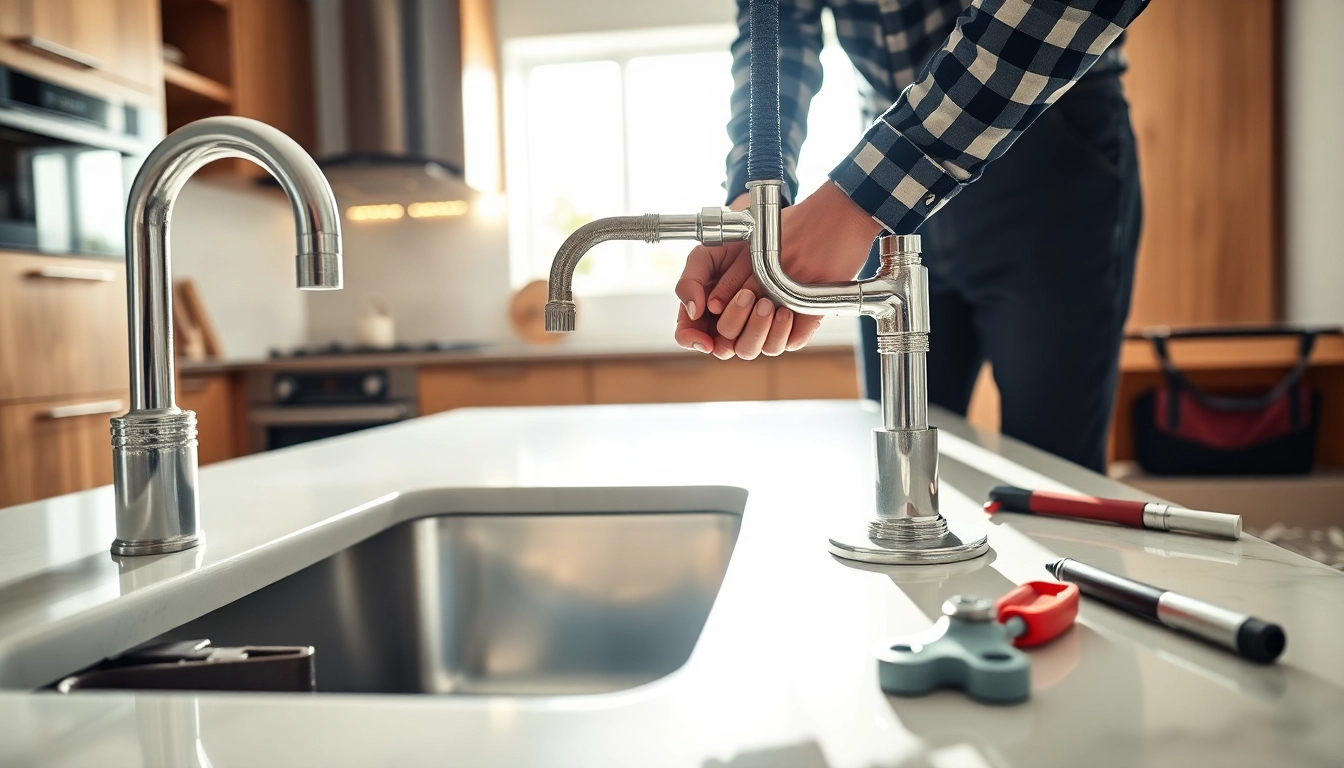Understanding Basic Plumbing Concepts
What is Plumbing?
Plumbing encompasses systems designed to convey fluids for various applications. These systems predominantly consist of pipes, valves, plumbing fixtures, tanks, and other apparatuses that facilitate the flow of water and other liquids. Effective plumbing is essential not only for residential and commercial buildings but also critical for sanitation, heating, and water distribution systems. The purpose of plumbing extends beyond just functionality; it plays a vital role in public health and the safety of our environments.
At its core, plumbing involves understanding the basic laws of physics, particularly gravity and pressure. Water naturally seeks a level, and plumbing systems utilize this principle to transport it efficiently. This means that every installation, from the simplest faucet to complex industrial pipelines, must adhere to these fundamental laws to ensure proper operation and safety.
Essential Plumbing Tools
A well-equipped plumber’s toolkit is crucial for both day-to-day tasks and larger plumbing projects. Here are some essential tools that every homeowner and plumbing professional should have:
- Pipe Wrench: Useful for gripping and turning pipes and fittings.
- Adjustable Wrench: Versatile tool for nuts and bolts, often used in plumbing situations.
- Tape Measure: Vital for accurate measurements to ensure proper fittings and installations.
- Plumber’s Snake: Specialized tool for clearing clogged drains and pipes.
- Pliers: Essential for grasping and twisting various materials.
- Pipe Cutter: Designed to cleanly cut pipes to the desired length.
- Drain Auger: Effective for breaking through tough clogs in drains.
- Teflon Tape: Used to ensure watertight seals on threaded connections.
Having these tools at hand not only makes plumbing repairs more efficient but also empowers homeowners to take on basic plumbing tasks themselves.
Common Plumbing Terms Explained
Understanding plumbing terminology is crucial for any homeowner looking to engage in plumbing projects or communicate effectively with professionals. Here are some common terms explained:
- Fixture: An appliance or instrument that discharges water (e.g., sinks, toilets, bathtubs).
- Drain: A pipe that carries sewage and wastewater away from a fixture.
- Sump Pump: A pump used to remove water that has accumulated in a water-collecting sump basin.
- Trap: A U-shaped pipe designed to hold a small amount of water, preventing sewer gases from escaping into the home.
- Vent Pipe: A pipe that allows air to enter the plumbing system, preventing vacuum formation and ensuring proper drainage.
Identifying Common Plumbing Issues
Leaky Faucets and Pipes
Leaks are one of the most common plumbing issues and can lead to significant water waste and damage if not addressed promptly. A leaky faucet can waste over 3,000 gallons of water a year and lead to higher utility bills. Identifying the source of the leak is the first step in making repairs. Common causes for faucet leaks include worn washers, failed O-rings, or corrosion. For pipes, leaks usually arise from joint failures, corrosion, or water pressure fluctuations.
To repair a leaky faucet, start by shutting off the water supply and disassembling the faucet to inspect the washers and O-rings. Replace any worn-out parts and reassemble. For leaking pipes, look for signs of corrosion or cracks and use pipe tape or epoxy for temporary fixes, while planning for more permanent repairs like pipe replacement.
Clogged Drains and Solutions
Clogged drains are another common issue that can cause significant inconveniences. They often arise due to debris accumulation, foreign objects, or grease buildup. Simple DIY solutions include using a plunger or a home-made drain cleaner made from baking soda and vinegar. For more serious blockages, a plumber’s snake might be necessary.
Regular maintenance practices such as using a strainer in sinks and regularly flushing drains with hot water can help prevent clog formation. In professional settings, installing regular maintenance schedules to clear drains can significantly enhance efficiency and reduce downtime.
Water Pressure Problems
Inconsistent water pressure can change dramatically from one day to another and can be caused by several factors including clogs, leaks, or issues with municipal water supplies. Symptoms of water pressure problems can include faucets that produce weak streams, toilets that don’t flush properly, or appliances that take longer to fill.
To troubleshoot water pressure problems, first, check the pressure gauge if available. It’s vital to test for consistent issues in certain areas of the house, which may indicate localized problems in the plumbing system. Solutions may include clearing out pipes or consulting with professionals for more complex issues.
Preventive Plumbing Maintenance Tips
Regular Pipe Inspections
Regular inspections can help catch plumbing issues before they escalate into more serious problems. Homeowners should periodically check both visible pipes and hidden ones, such as those under sinks or within walls, for evidence of leaks or corrosion. Look for rust spots, damp areas, or mold growth which can indicate leaks.
Scheduling professional inspections can provide valuable insights into hard-to-reach areas and systems that are critical to the overall plumbing health of the home. Professionals often utilize camera systems to inspect pipe interiors, providing an accurate diagnosis of problems.
Seasonal Plumbing Checks
Seasonal checks can help prepare your plumbing system for changes in temperatures which may lead to problems, particularly in winter months. Before the onset of cold weather, ensure that outdoor hoses are drained and stored, and pipes in unconditioned spaces are insulated to prevent freezing and bursting.
Similarly, summer checks should focus on ensuring clean, blockage-free gutters and downspouts to prevent water overflow and erosion, and checking irrigation systems to optimize performance.
Tips for Winterizing Your Plumbing
Winterizing plumbing can save homeowners from costly repairs due to frozen pipes. Here are key steps to take:
- Insulate pipes that are exposed to cold temperatures, particularly in basements and attics.
- Allow faucets to drip slightly during extreme cold, which prevents freezing.
- Keep the thermostat set to a consistent temperature and ensure adequate heating throughout the home.
- Shut off outdoor faucets and drain any remaining water.
Essential Plumbing Projects for DIY Enthusiasts
How to Install a New Faucet
Installing a new faucet can be a rewarding DIY project. Begin by turning off the water supply, then disconnect the existing faucet by removing the nuts and washers. After cleaning the area, position the new faucet in place and secure it according to manufacturer’s instructions. Reconnect the water supply, then turn the water back on and check for any leaks.
This project not only enhances functionality but also offers an opportunity to choose a design that aligns with your home aesthetics.
Repairing a Leaking Pipe
Repairing a leaking pipe is a task that can save you both time and money. Start by cutting off the water supply to the affected section. Use a pipe cutter to remove the damaged portion and replace it with a new section. Use appropriate fittings and connectors to ensure a secure and watertight seal. Lastly, restore the water supply and check for leaks.
Upgrading Bathrooms Efficiently
Bathroom upgrades can dramatically improve both aesthetics and functionality. When planning an upgrade, consider energy-efficient fixtures which can lower water consumption without sacrificing performance. For example, low-flow toilets and showerheads can save money on water bills.
Moreover, layouts can also be optimized for better space usage. Replacing old plumbing fixtures during an upgrade allows for modernization and potential improvements in home value.
Knowing When to Call a Professional Plumber
Signs You Need Professional Help
While many plumbing tasks can be tackled by homeowners, there are instances where professional help is essential. Signs you might need a professional include persistent leaks, low water pressure issues that cannot be identified, or the need for complex installations or repairs. If you experience significant water damage or suspect major blockages, it’s best to consult with a professional plumber for assessment and resolution.
Emergency Plumbing Services
Emergencies can arise suddenly and require immediate attention. Issues such as burst pipes, sewage backflow, or extensive leaks fall under emergencies. Prompt action is necessary to mitigate damage and restore function to your plumbing. Having a trusted professional on speed dial can save both time and money during these urgent situations.
Choosing the Right Plumbing Service
Selecting the right plumbing service involves careful consideration of several factors. Look for licensed and insured professionals to ensure quality and compliance with local regulations. Seek referrals from trusted sources, and make sure to check reviews and ratings of potential service providers. Obtaining quotes from multiple plumbers can also help you make an informed decision based on quality and budget.
Through understanding and preventive measures, homeowners can effectively maintain their plumbing systems and address issues as they arise. As showcased, being proactive not only extends the life of plumbing systems but also conservatively enhances the home’s lifespan and value. For comprehensive plumbing solutions, always equip yourself with knowledge and the right resources.



